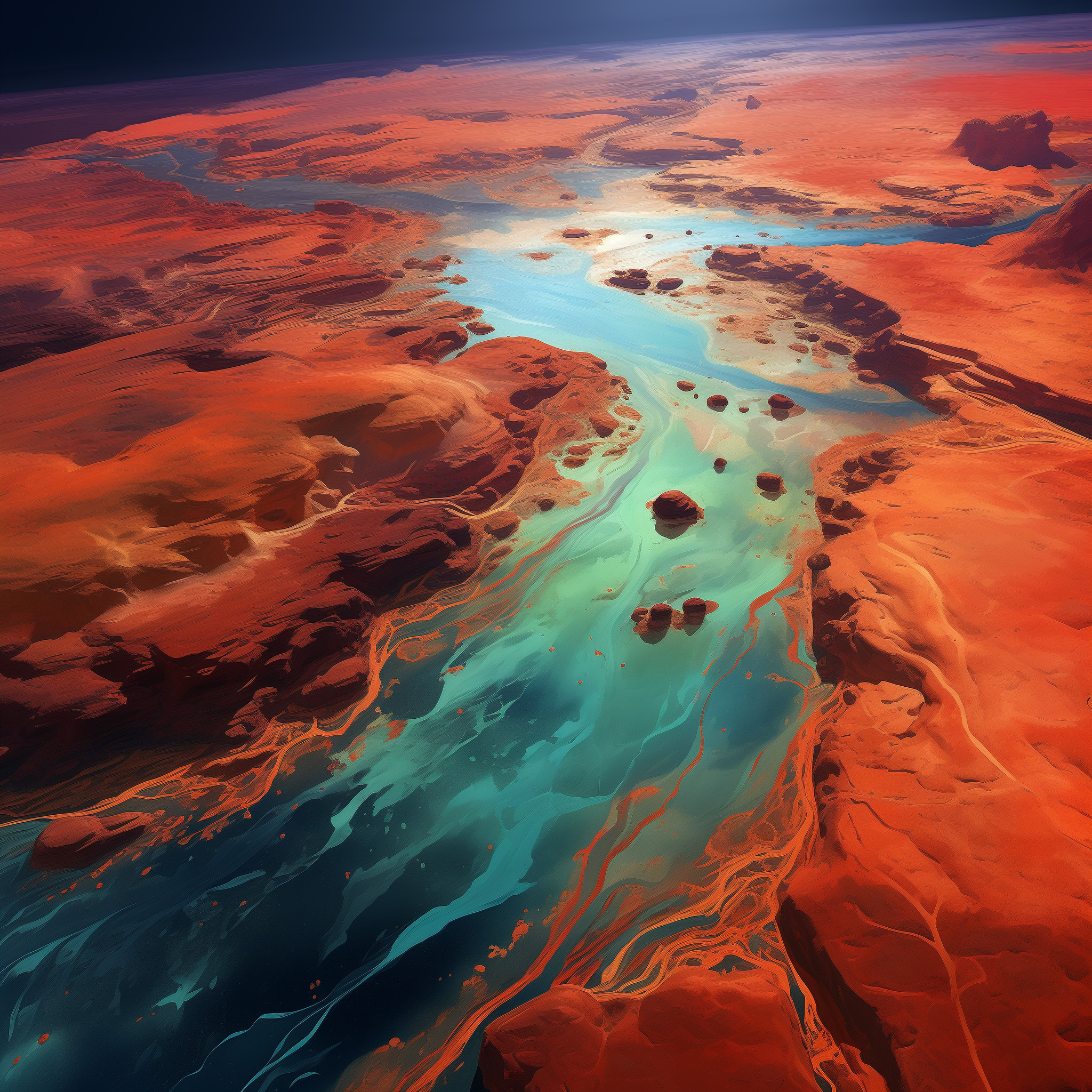Rosia
Salika's Knowledge #253
Planet Rosia, also known as the domain of the Goddess Flora. It is so close to our world of Vreathe, but it seems to be just out of reach at the same time. Many people say the world is a red paradise, a place of happiness and peace, just like Fora herself was. I almost don't want to spoil it for them...
The planet is a red desert and has been for quite some time. It has an ocean yes, and you can see the ocean with a powerful enough telescope, like the one at the Golden Observatory in Irrelith. But, that is just a failed eeffort by the Silver Race to terraform another world. They managed to fill the world with water, but ultimately failed to make Rosia a world of life. Maybe it is a task the Elves and Iron Humans can finish, someday, but I doubt it...
- Salika
Flora's Domain
Planet Rosia has captivated people of the Iron Age for generations. It appears like a little red dot in the sky, and when viewed with large telescopes, the world appears to have a very large blue ocean, covering almost a third of the world. This has given rise to the belief that the world is filled with life, but that couldn't be further from the truth. The World is a dead one. Still the belief persists that this is an another world that humans can live on if they can somehow reach it someday. Not even the Orcs, the most advanced race of Vreathe, has the technology to leave Vreathe to visit another world. At least not yet.
It is true that the world is the domain of the goddess Flora, who has control over all the flowers of the world, our world. She never created a single plant that could live on Rosia. It is said that she never went to make the world her own either even though she owned it. She left it alone and instead stayed on Vreathe. She spent countless years filling that world with life instead. Because of her efforts, we have countless species of flowering plants, from little grasses to gigantic trees, each that can be appreciated for their own specific beauty and usefulness. If Flora had actually left Vreathe to be on her own world, life just could not be what it is today.
History
Terraformed Moon
To understand how the effort to terraform Rosia failed, we need to go back to near the beginning of the Silver Age. Lapis II was the seventh queen of the Olimians. Growing up, she always had her eyes on the stars instead of on the world she walked on. In the year 101 kSA, a few thousand years after becoming queen, she instructed her scientists to devise a way to leave the world of Vreathe and land on other worlds.
The scientists managed to find several ways, but none were more effecitve than ships powered by Gravity Stones. It requires a good bit of math, but they found a way to overload the aethercite crystals to move at great speeds away from Vreathe, and if they could slingshot their ships properly, be at other worlds in a matter of days or weeks.
Lapis II was one of the first people to leave Vreathe in this manner and step foot on another world. She stepped on the Greater Moon Kalbeth. She then instructed her scientists to figure out a way to terraform this world. Lapis would die long before this was accomplished. It was near the end of Queen Issia's reign in the year 172 kSA that the greater moon became a living world filled with water and life. Her people, the Kwin Tribe would settle that world, and would become the Moon Folk. Their descendants today have the Moon Trace, and the Fairies of Vreathe can also trace their ancestry to them.
First ships to Rosia
After this success, Queen Issia had the Olimians set their sights on other worlds. the planet Rosia was one of them. They had to get permission from Flora herself first, but she was so busy devising new types of plants that she ignored the queen's attempts at speaking to her for over a thousand years. When an audience was finally granted, Issia was long dead (after having a reign of fifty thousand years), and Queen Issia III had taken control.
Flora allowed the Olimians to settle and terraform her world, but she didn't really see the point if Vreathe was such a lovely world already. Issia III wasted no time in commissioning ships to take settlers to Rosia to settle and terraform the world. These ships were quickly constructed, if you consider 500 years quick, and in the year 177 kSA, these ships traveled to Rosia.
When the ships landed on the world, they found nothing of value. Everythign was rusted red, there was no atmosphere, no water, no life, nothing of value. This world was also much larger than Kalbeth was and would take several times longer than the 40,000 years or so it took to terraform that world. The Olimians thought they were up to the task and immediately made plans for how they were going to get water, air, and more to this world.
Terraforming Efforts, Part 1
The Olimians worked dilligently. They traveled throughout the star system, gathering comets with great amounts of water to slam into the world. This would create the water they needed. It took thousands of years. The Reigns of King Yarla, King Kurum, Queen Lapis IV, King Ishme, and King Sabium all passed. By the year 250 kSA, Rosia was filled with water. It also had several new large craters, but that was a footnote in the efforts the Olimians made in terraforming this world.
They now needed plants that could live on this harsh world to turn the carbon air into oxygen. The Olimians went to Flora, who, busy with devising new plants for Vreathe, took over a thousand years to listen to them. She wasn't even aware that Queen Lapis III was long dead. King Sabium requested that Flora devise a plant that could survive the harshness of Rosia. Flora already had plants that could. They were her smallest creations, but would create all the air the Olimians would ever need.
Flora traveled with King Sabium and Olimian settlers to Rosia. Flora saw her formerly red world filled with water, but it was ugly to her. She used her power and created a great wave of green swept over the world, filling it with a countless number of algae. Seaweed filled the oceans and green slime covered the land. Flora then requested to be taken back to Vreathe, for she had no desire to be on her own domain.
Put on Hold
The efforts to terraform Rosia were put on hold starting in the year 261 kSA. Queen Lapis V was plotting against all of the gods, and she was going to send an army to Meliheal to free the dark god Tazil. Many resources dedicated to Rosia were taken away. Lapis V did not see her goal fall through. The task fell to her daughter, Queen Lapis VI instead, who in the year 285 kSA, attacked the World Tree, angering all of the gods. This started an almost hundred thousand year reign of the elder gods Alom and Yanneth, who would not allow the Olimians to leave the world. They did in secret, but not to Rosia. They went to The Moon Izi to build great weapons in secret, to overthrow them.
Terraforming Efforts, Part 2
After Alom and Yanneth were overthrown, being imprisoned with Tazil on the moon Nodan, the Olimians continued their goals. The issue is that the ones of the Silver Race who were terraforming Rosia, had been dead for many thousands of years, and this was considering their extended lifespans. Some Olimians still had a desire to terraform the world like their ancestors, so they traveled to the world. They assumed that there was more than enough oxygen to bring animals along, as well as more varieties of plants. During the reign of King Sinkashid, the terraforming of Rosia was said to be complete.
The Silver Race then built several great cities on the world. Efforts to maintain the world were put on hold towards the end of the silver age however. The olimians were attempting to build a great Crystal Tower that would grant them immortality. They needed all of the Aethercite they could find. A large chunk of this aethercite came from the planet Rosia.
In the year 450 kSA, when the crystal tower was turned on, it exploded, causing the Silver Age Cataclysm, sending a magical wave of energy across Vreathe then to the stars beyond. This created elves, fairies, and all manner of beings. On Rosia, the Silver Race were shaped beyond recognition. Half of them turned into great lumbering beings of iron, and half turned into gentle beings of wood and grass. They were the Ironmen and the Grassfolk.
The Bronze Age
This would be the end of the story, but it isn't. Flora still didn't care for her world. She continued her task of creating new types of flowers to fill Vreathe with, even through the Bronze Age, which lasted just over 45,000 years. While the other gods were warring amongst themselves and attempting to enslave the humans and elves, Flora continued her task. It wasn't until the end of the Bronze Age when Saint Nora threw every god and goddess off of Vreath and barred them from even landing on the world again.
Flora, who spent hundreds of thousands of years with her one task, creating flowers, was a little broken up. She pleaded with Nora to let her back on Vreathe to continue her task, but Nora would not allow it. Flora then resigned herself to go back to her world. What she saw was not what she was expecting.
Flora had assumed that the Silver Race were like her, they would continue their task until the end of time, and that isn't untrue...if the silver race wasn't transformed beyond recognition. The Ironmen and Grassfolk had originally tried working together, but eventually this broke down. They were at war with each other. They had mined and cut the world dry of its resources, killing every plant and animal, to build their machines and fuel their war against each other that had lasted for many millennia.
Rosia was a dead, a red world, then it became a world filled with life. Now it was a dead, red world once again.
Flora sent a wave of aetheric energy across Rosia, killing everything. the Ironmen and Grassfolk were no more. Flora then looked at her world, there was very little here. She decided that if she couldn't go to Vreathe, she would start over here. Without resting at all, she started the tast of filling Rosia with life once more.
The Iron Age
She didn't get far. The red desert and and empty blue oceans was all there was and didn't provide much inspiration. Flora had nothing inspiring her, nothing driving her. All her crafts died quickly after creation. Angry that she lost her creative spark, Flora then looked back on Vreathe, admiring her creation, resigning herself to that, thinking she had created enough.
Flora, the Goddess of Flowers, sits on a throne of red stone, over a lifeless domain that remains lifeless, but she was finally content. She could finally rest. While most of the gods are attempting to break their way back into Vreathe to gain power and control everything, Flora makes no effort to do so.
Flora now sleeps, more than any other god. She still occasionally wakes and looks over at the world of Vreathe, happy that it is still filled with life.




Comments